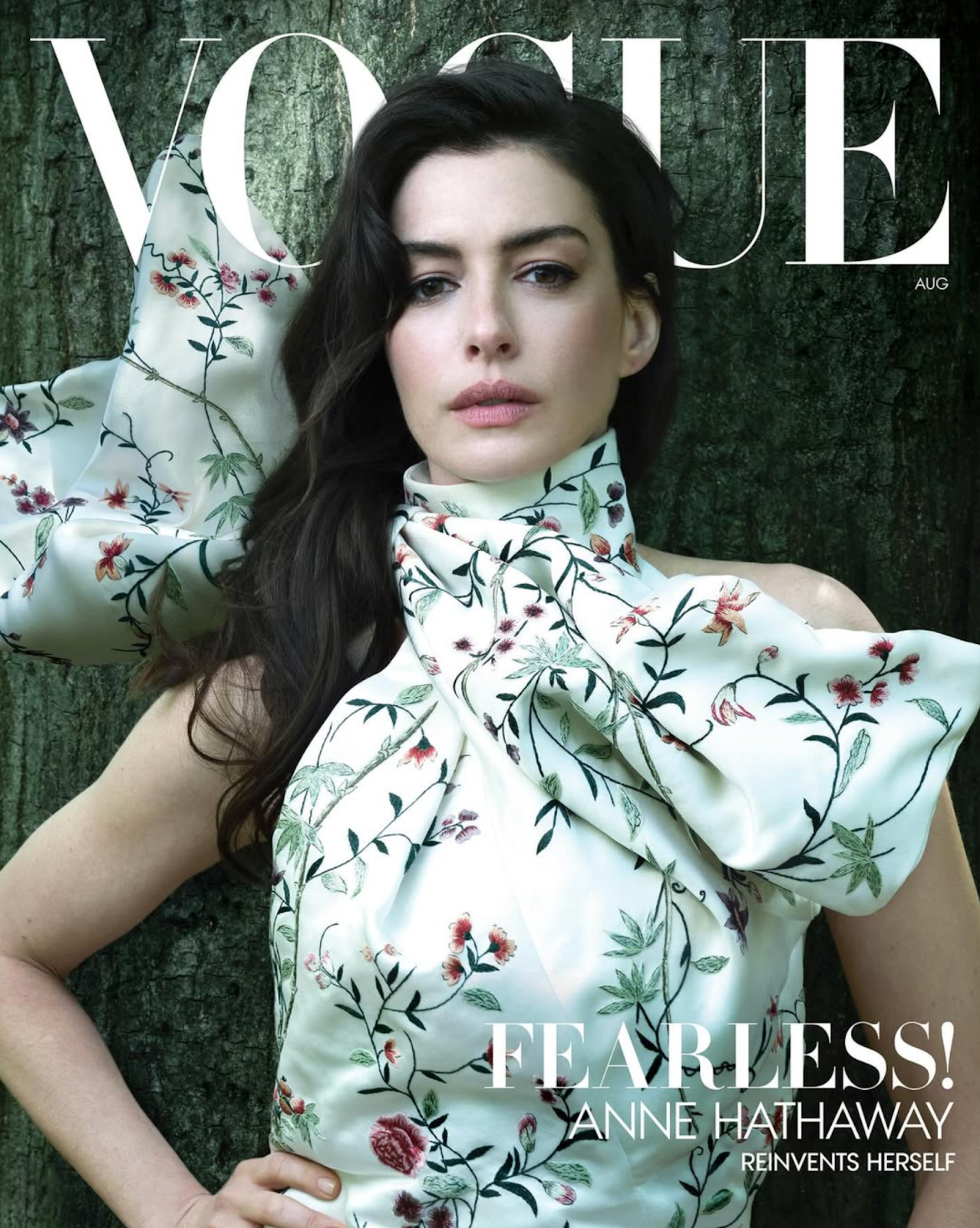The Seamstress of Stardom: Anne Hathaway’s Tailored Take on Fame
Cue the red carpet, Anne Hathaway is back and serving stitched-up stardom on a silver (Vogue-branded) platter. The August 2025 cover star has officially entered her maximalist era, and we couldn’t be more ready. With not one, not two, but three major films looming (Mother Mary, The Devil Wears Prada 2, and yes you are not imagining it is quite real, The Princess Diaries 3), Hathaway is spinning more career comebacks than your favourite Y2K pop diva. As if she ever left.
Let’s dive into the headline act: Mother Mary. Anne as a glitter-drenched pop star spiraling into an existential crisis who abruptly ditches her sold-out tour to reconnect and seek refuge with Sam (played by the formidable Michaela Coel), the fashion designer who once sculpted her stage persona. Picture a spiritual retreat, but with industrial sewing machines and emotional exorcisms. The film’s working tagline might as well be: When couture meets catharsis.
Directed by David Lower, the awaited Mother Mary explores the complexities of motherhood, identity and fame all the while being laced with biblical undertones and feminist energy. The biblical story of Mary's immaculate conception can be viewed as a loss of autonomy, where Mary simply becomes a vessel for a man's desire, and this theme may be explored in the film with Anne’s search for purity and redemption.
What makes this all the more remarkable is Hathaway’s admission that she approached this role not from the pedestal of an established performer, but with the humility of someone starting over. In a cultural landscape obsessed with excellence, where achievement is filtered, airbrushed, and posted for mass approval, Hathaway’s choice to begin anew and to risk failing in front of the world, feels revolutionary.
We live in an era that has made a commodity of perfection. We idolize success stories, yet recoil at the messiness of growth. It's become all too common to avoid new challenges simply because we fear looking amateur, unpolished, human. But Hathaway, in one of her most high-profile roles to date, walked straight into that discomfort. That kind of vulnerability? It’s couture courage.
And maybe that’s the true symbolism of the dress in Mother Mary. Not just a showpiece or performance costume, but a physical manifestation of imperfection, repair, and love. Each seam a scar. Each embellishment, a memory. It is their reconciliation stitched in silk. Their forgiveness hemmed in glitter. Their friendship, messy and mended, made wearable.
Hathaway, despite being an Oscar-winning actress, trained in vocal performance and dance for the role, a detail she doesn’t flex so much as confide to us – "I started from scratch, like a beginner," she told Vogue. Even icons, it seems, aren't exempt from imposter syndrome.
Now, let’s talk fashion, because this film has couture drama sewn into its plot. Central to Mother Mary is a dress – yes, one singular garment – designed in a 13th-century German barn that becomes the emotional epicenter of the film. The fashion? Devastating. The plot? Curiously vague. But what we do know is that at the heart of this emotional fever dream is a dress – a single garment, crafted by Mary and Sam in a secluded 13th-century barn, that becomes a symbol of their entire shared history: the chaos, the creation, the connection. It’s not just couture – it’s confession. It’s communion. It’s trauma therapy with sequins. Hathaway and Coel's characters collaborate on it with raw, spiritual intensity. The dress is not just a dress. It's a metaphor: for trust, for creation, for the painful joy of making art with someone who sees all your mess and still chooses to stay. The barn setting becomes their confessional.. One week of filming that scene left the cast and crew saying it felt more like a ritual than a shoot. It’s giving religious allegory, but make it fashion.
In that barn, the two women pour their tangled friendship and fractured selves into the making of something transcendent. Hathaway herself described the experience as “spooky action,” a quantum entanglement of souls stitched together by art. When she sobbed mid-fitting and Michaela whispered, “I love you, I trust you,” they weren’t just rehearsing – they were unraveling. And what emerged was not just a costume, but a literal embodiment of their emotional labor.
The 13th-century barn, where much of the action takes place, might symbolize a return to a more primal or authentic state, a place of refuge from the pressures of the modern world.
But if Mother Mary is Anne's art-house redemption arc, then The Devil Wears Prada 2 is her nostalgic victory lap. Reprising Andy Sachs nearly two decades later? We have not seen the last of the cerulean sweater discourse, and honestly, that’s a cultural reset we welcome. And just to ensure full Gen-Z-meets-Millennial crossover, she's also dusting off the tiara for The Princess Diaries 3. Genovia, consider us seated.
So what does this triple-threat renaissance say about Hathaway? Maybe it's that she’s not here to be easily categorized anymore. She's not your intern. She’s not your princess. She’s not your pop diva. She’s all of them, sewn together, hemmed with self-awareness.
In a world terrified of messiness, Anne Hathaway is embracing the chaos of growth. And lucky for us, she’s making it look damn good.
XOXO, The Fashion Stock Market
Cover Photo: Vogue
Editor: Felicity Field
Photo: Vogue
Photo: Vogue
Photo: Vogue


